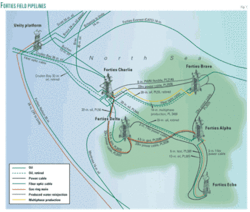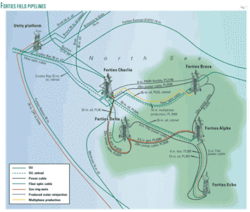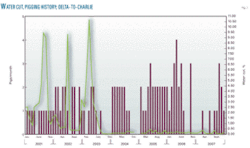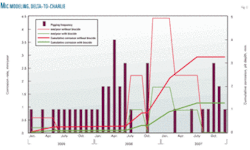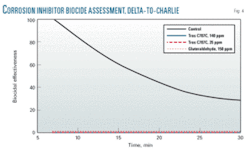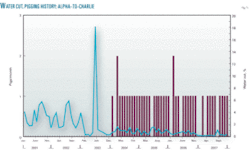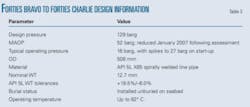Identifying unmitigated microbial-influenced corrosion (MIC) rather than mitigated or even unmitigated CO2 corrosion as the highest risk to infield oil transport pipeline integrity has led to a change of emphasis in corrosion control, with the emphasis placed on water cut control at slow flow rates and optimization of the pigging program.
Microbial corrosion modeling can be used in addition to CO2 corrosion modeling to show historical, present, and predicted future corrosion rates, leading to an increased level of confidence in future operations where pipelines damaged by MIC continue to be used.
This first of a two-part article concentrates on MIC modeling and subsequent intelligent in-line inspection of Forties pipelines. The concluding article (next week) will detail a leak that occurred despite these efforts and the response to it.
Background
Forties field began producing in 1975. Production from the field peaked in 1978 at 520,000 b/d. Acquired by Apache in 2003, the field still ranks in the top four North Sea fields in production and reserves even after having produced more than any other North Sea field: roughly 2.6 billion bbl to date. Apache raised production from 42,000 b/d to a peak of 81,000 b/d. In 2006, average daily production exceeded 58,000 b/d.1
Forties field consists of five platforms, Forties Alpha, Bravo, Charlie, Delta, and Echo (Fig. 1). Forties Charlie acts as the central hub for all Forties production as well as for several other UK sector North Sea fields, and ships Forties output with the 36-in. OD Forties Pipeline System (FPS) export line to Cruden Bay via the Unity platform.
Forties Alpha, Forties Charlie, and Forties Delta platforms have separation and processing facilities. Conversion of Forties Bravo platform from oil to direct export (transport of nonstabilized multiphase produced fluids) included removal of separation and processing facilities.
Forties Echo platform does not include separation facilities. Nonstabilized multiphase oil-gas-produced water flows onto Forties Alpha for separation train processing. Table 1 describes Forties field’s in-field pipeline system.
Low oil prices in the 1990s led to cuts and cost savings throughout the UK North Sea. The corrosion consequences of many of the operational deficiencies of the 1990s have only recently become apparent. Higher oil prices and increased emphasis on maintenance of ageing pipelines have prompted operators’ efforts to stabilize the current corrosion situation and, where required, take remedial action.
Apache found a number of pipeline corrosion issues requiring examination on taking ownership of Forties. This article examines integrity issues tied to the in-line inspection program, including:
- Microbial-influenced corrosion (MIC) modeling of Forties’ in-field pipelines, operational pigging, and water cut control.
- An intelligent pig run that failed to identify a defect, leading to a subsequent leak.
- The importance of rapid response when pipeline integrity issues occur.
MIC, modeling
CO2 corrosion modeling and risk assessment have established MIC as the highest risk corrosion mechanism for in-field oil transport pipelines.2
Low separator pressures and high levels of corrosion inhibition kept the probability of CO2 corrosion in the oil transport lines low. The in-field oil transport lines act as feed source for inhibitor for the entire Forties pipeline system, requiring the high levels of corrosion inhibition. These lines, however, now transport <15% of their design capacity and flow rates are <0.3 m/sec. Arrival temperatures at Forties’ Charlie facilities measure 20-25° C., creating a high risk of unmitigated microbial corrosion.
An intelligent pigging program led to replacement of one infield pipeline (Forties Bravo to Forties Charlie). Work on a second pipeline (Forties Delta to Forties Charlie) began in May 2009. Damage has occurred predominantly as isolated pitting at the 6 o’clock position. In some cases, however, pits have merged together to produce longer axial-length defects.
Operational requirements demanded investigation of two issues:
- Usability of the existing Forties Delta to Forties Charlie pipeline until its scheduled replacement in early 2009, given identified corrosion rates and damage profile
- Predicted MIC rate for life prediction of the Forties Alpha to Forties Charlie pipeline.
Microbial corrosion modeling, developed by Pots,3 sheds light on these issues. Parameters influencing MIC rates include temperature, flow rate, water cut, pigging frequency, and biocide treatment. Commercial Microbiology Ltd. deployed a modified variant of the Pots microbial corrosion model on Forties Alpha to Forties Charlie and Forties Delta to Forties Charlie oil transport pipelines.
Delta-to-Charlie pipeline
Installed in 1975, the Delta-to-Charlie pipeline received its first intelligent pigging in 1998. Risers had remained in relatively good condition. Pitting and axial grooving damage, however, existed at the 6 o’clock position of the transport line. Pipeline wall penetration and defect growth rates required derating of the maximum allowable operating pressure (MAOP) to continue use. A 2001 reinspection found no meaningful defect growth rate, allowing the line to continue functioning at its reduced MAOP.
A 2007 reexamination of worst-case defects found in 2001 observed no defect growth. But completely new defects appeared and growth of some of the smaller defects had accelerated. Corrosion rates measured >1 mm/year, faster than could be accounted for by CO2 corrosion. Even assuming inhibitor efficiency of 0%, the worst case modeled CO2 corrosion rate measured 0.5 mm/year. Evidence of sulfate-reducing bacteria (SRB) activity and H2S formation in other pipelines in the field and topsides facilities, combined with risk assessment results, led this damage to be attributed to MIC.
Fig. 2 presents historical water cut and cleaning pig data for the Forties Delta to Forties Charlie pipeline. Water cut control was relatively poor before 2003. After 2003 water cut control improved. Cleaning pigs have since run on a regular basis. Between mid-2006 and mid-2007, however, damage to an isolation valve caused few pigs to run.
Fig. 3 presents results of MIC modeling for this pipeline from 2005 onwards, a period in which the water cut was low. Predicted microbial corrosion rates generally measured <0.1 mm/year, with the previously discussed exception from mid-2006 to mid-2007. While pigging frequency was reduced, predicted corrosion rates peaked at more than 4 mm/year in the absence of biocide, raising the possibility the damage noted between 2001 and 2007 occurred during this period.
But the pipeline used high levels of corrosion inhibition during this period. Even assuming corrosion inhibition is ineffective against MIC, the toxicity of the high dosage (well in excess of 100 ppm, based on total fluids) and its tendency to partition in the aqueous phase should have made it relatively biocidal.
Fig. 4 confirms the inhibitor’s biocidal capability in the aqueous phase. The corrosion inhibitor at concentrations as low as 35 ppm is as biocidal as gluteraldehyde at 150 ppm. Fig. 3 shows the total predicted 2005-08 metal loss in the presence of a biocide as <1.5 mm. This level of biocide is inconsistent with the damage found by comparing intelligent pig runs from the period. High rates of MIC between 2001 and 2003 more likely caused the damage during the high water-cut periods.
Subsequent relatively low MIC rates brought about by an effective pigging program have allowed replacement of this pipeline to be scheduled to coincide with a planned 2009 shutdown of Forties Delta platform.
Processed-oil pipeline
Installation of this replacement for PL54 occurred in 1995. It was intelligently pigged in April 2009. Although the full results of that inspection are still being prepared, preliminary reporting shows the pipeline remains fit for service.
Fig. 5 shows water cut control was relatively poor before 2003. Control improved substantially after 2003. MIC modeling carried out by Commercial Microbiology Ltd. predicted corrosion rates as high as 2.2 mm/year, with rates reduced to <0.1 mm during periods of low water cut and effective pigging. These rates, combined with the fact the original line required replacement after only 20 years of service, lead to the 2008 intelligent pig survey.
Water-cut control
Intelligent pig results, combined with risk assessment and microbial corrosion modeling, prompted changes in water cut control and pigging operations.
Previous water cut limits stood at 2%. Industry participants generally believe holding water cut <1-2% allows mitigation of water drop and associated microbial and corrosion issues, an erroneous belief to some extent. A 1-2% water cut can be successfully entrained, even in light crudes.4 Entrainment, however, requires maintaining a crude flow rate of >1 m/sec. As flow rate drops below 1 m/sec, a rapid drop in water entrainment capability occurs, and light crudes flowing at low velocities (<0.2 m/sec) might have difficulty maintaining even 0.2% water entrainment.
Design of many North Sea facilities’ pipelines envisioned peak oil flows well more than current rates of =1 m/sec. A 1-2% water cut assumption under these circumstances is not an acceptable integrity criterion.
Processed oil water cuts in Forties field under Apache have typically measured <0.5%. Flow rates in the infield oil transport lines, however, are <1 m/sec and the water entrainment capability of the relatively light Forties field crude will be lower than this value. The key performance indicator (KPI) for water cut now reflects this situation and provides a stepped water content target based on pipeline flow velocity. Table 2 shows the modified KPI.
Intelligent pigging
On Apr. 4, 2008, the Forties Bravo to Forties Charlie pipeline, converted to multiphase flow in late 2006 after 31 years as a processed oil transport line, suffered a minor leak. The pipeline had a design pressure of 129 barg. In January 2007, an MAOP reduction to 52 barg followed an assessment based on corrosion modeling and comparison with internal corrosion seen in other pipelines with similar operating conditions. Table 3 shows summary design information for the pipeline.
An in-line inspection shortly before the leak occurred confirmed widespread internal corrosion but no more than incidental metal loss at the leak. The leak occurred at the intersection of a line pipe spiral weld and the butt weld between two pipe lengths, near the bottom of the pipeline.
An in-line inspection in 1990 by H. Rosen Engineering GMBH of the Forties Bravo to Forties Charlie pipeline using a corrosion-detection pig reported limited internal corrosion. Apache selected GE Energy’s Pipeline Integrity International division for its initial in-line inspection program, using its MagneScan TRIAX in-line inspection technology.
This technology can read magnetic flux leakage (MFL) signals on three separate axes (vs. the one or two used by traditional MFL tools) enabling detection of general and axial defects from the same inspection data and offering improved sizing capability compared with traditional MFL tools. Table 4 offers a comparison of sizing capabilities.
Anticipated flow velocities in the pipelines of less than the minimum 1 m/sec for standard MFL required use of the GE system with its minimum velocity of 0.3 m/sec. Delays in performing the surveys, however, pushed inspection of the Forties Bravo to Charlie pipeline to after the change from transmission of processed crude oil to the direct export of multiphase water-crude oil-gas, resulting in increased flow velocity.
The in-line survey of the Forties Bravo to Charlie pipeline in June 2007 identified widespread internal corrosion, particularly at the 6 o’clock position at the bottom of the pipeline. The corrosion damage consisted of numerous individual features, the vast majority of which measured <30% WT and lay within the first 3 km from Forties Bravo. The deepest features had a relatively short axial length. The inspection also identified evidence of preferential weld corrosion, although none of these instances was identified as serious.
Inspection reported two internal metal loss features with depths >80% WT; 83% × 88 mm and 85% × 33 mm (peak depth as percentage of nominal WT × axial length). Assessment of the corrosion features, however, did not deem any to be unsafe at the pipeline’s current 52 barg MAOP (reduced from its original 129 barg), the highest calculated estimated repair factor (ERF) measuring 0.720. ERF is the ratio of MAOP to the calculated safe operating pressure for the identified metal loss features. An ERF value >1 indicates an unsafe condition if the pipeline is operated at or above the MAOP. DNV RP F101, October 2004, guided determination of the safe operating pressure.5
The typical pipeline operating pressure of 16 barg, with pressure spikes up to 27 barg, prompted the operator to consider failure by leak more likely than failure by rupture.6 Continuing internal corrosion at the deepest metal loss features such as the two features with peak depths >80% would most likely cause these leaks, despite continuing efforts at corrosion mitigation through inhibition and routine pigging.
A repair program proposed for the pipeline was to address the highest metal-loss features, with additional repairs occurring during the pipeline’s remaining life (to 2020).
The combination of predicted lifetime repair costs and future risk of leakage prompted a decision to replace the pipeline. Agreements for supply of line pipe and installation of the replacement pipeline occurred within days. Installation of replacement line took place during September 2007, with tie-in of the existing 20-in. OD risers at Forties Bravo and Charlie scheduled for the next platform maintenance program in April 2008.
References
- http://www.apachecorp.com/About_Us/Global_Strategy_and_Operations/Operations_Overview/UK_North_Sea/
- Marsh, J., Teh, T., Ounnas, S., and Richardson, M., SPE 114141-MS, “Corrosion Management for Ageing Pipelines—Experience From the Forties Field,” SPE International Oilfield Corrosion Conference, Aberdeen, May 27, 2008.
- Pots, B.F.M., NACE Corrosion 2005, Paper 05550, “Prediction of Corrosion Rates of the Main Corrosion Mechanisms in Upstream Applications,” Houston, Apr. 3-7, 2005.
- Nesic, S., Cai, J., and Lee, K.J., NACE Corrosion 2005, Paper 05556, “A Multiphase Flow and Internal Corrosion Prediction Model for Mild Steel Pipelines,” Houston, Apr. 3-7, 2005.
- DNV RP F101, Recommended Practice RP-F101 “Corroded Pipelines,” October 2004.
- NR99035/4238.1.711 R3 “The Leak-Rupture Behavior of Defects in Pipelines,” September 2002.
